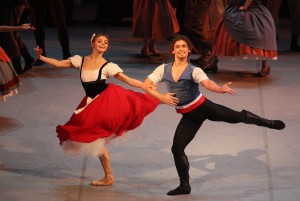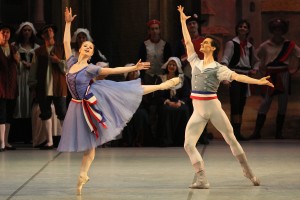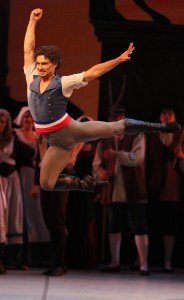Segerstrom Center for the Arts Executive Vice President Judy Morr adores Russian ballet and loves to make history. She was the first U.S. presenter of Eifman Ballet – also appearing this season at the center – and she makes sure the Mariinsky and Bolshoi ballets perform as often as possible.
 But past Segerstrom Center events could barely penetrate Morr’s anticipatory zeal as she sat down recently to discuss the long-awaited arrival of the Mikhailovsky Ballet and Orchestra on its first tour of the U.S., which is stopping only at Lincoln Center and in Costa Mesa. In gentle tones, she admitted flat out: “I like being first.”
But past Segerstrom Center events could barely penetrate Morr’s anticipatory zeal as she sat down recently to discuss the long-awaited arrival of the Mikhailovsky Ballet and Orchestra on its first tour of the U.S., which is stopping only at Lincoln Center and in Costa Mesa. In gentle tones, she admitted flat out: “I like being first.”
Another St. Petersburg phenomenon, the Mikhailovsky Ballet had been on Morr’s radar since 2007, when Russian businessman Vladimir Kekhman, founder of a billion-dollar fruit import business, was named general director of the Mikhailovsky Theater. He quickly poured millions of dollars into the historic Arts Plaza building as well as the revival of its wan, uncharted ballet company, formerly known as Maly Opera Ballet.
Surprisingly, it all clicked into place. Soon after, Morr saw the enhanced company perform in its restored, 1833 jewelbox theater. “You could just reach out and touch them,” she said. She wanted to book the troupe immediately; she spent four or five years in pursuit.
In the pressurized world of top-tier Russian ballet, a lot can happen in a few years. By 2013, Kekhman had declared personal bankruptcy, plus there have been some eventful entrances and exits. After three years as artistic director, distinctive contemporary Spanish choreographer Nacho Duato left this year for Germany, to direct Staatsballett Berlin, though reports say he will continue as the Mikhailovsky’s resident choreographer.
Bolshoi superstars Natalia Osipova and Ivan Vasiliev, who joined the troupe as a couple back in 2011, have since split and resigned from the Mikhailovsky (she joined London’s Royal Ballet; he freelances internationally). Under their contract, however, they continue to perform as guests, though only Vasiliev will appear on the Costa Mesa tour leg.
As the troupe readied for this U.S. tour, the true guiding hand of the Mikhailovsky’s flourishing regrowth since 2009 – Bolshoi-trained ballet master Mikhail Messerer – suddenly rose to the fore. Though well-respected in England, where he’d been a permanent “guest teacher” for the Royal Ballet since the 1980s, Messerer’s quiet, early appointment to the Mikhailovsky, predating Duato, speaks to the company’s equal commitments to 19th century ballet, distinguished 20th century repertory and modern choreography.
By phone recently from New York, while preparing for the Lincoln Center debut, Messerer described the resurrection of “The Flames of Paris,” an allegorical French Revolution ballet created in 1932 that features choreography by Vasily Vainonen and music by Boris Asafiev, based on the novel “Les Rouges du Midi” by Felix Gras. Morr specifically requested “The Flames of Paris” for the Segerstrom Center, as the ballet has never been presented in the United States (in New York the company also brought “Giselle” and a mixed bill of 20th and 21st century short works).
Though buried for decades, the story of a revolutionary couple who meet during the march of a Marseille detachment to Paris had once been one of Russia’s most-beloved ballets, with a lively score and famous pas de deux still used in international ballet competitions and all-star programs. In its time, “The Flames of Paris” was produced in both St. Petersburg and Moscow, first in 1932, during the first post-revolution years, then again in 1947, as one of the first revivals intended to revive spirits after World War II. Yet the ballet was shuttered during the Cold War years, without any preservation attempts.
Messerer had a strong connection to the work that ran through generations. He hails from a proud dynasty of Moscow ballet performers and pedagogues, which he signaled early in his dancing career when he took his mother’s maiden name. His mother, Sulamith Messerer, and his uncle Asaf Messerer both danced lead roles at the Bolshoi, and later became heralded teachers.
Tutored by Sulamith, Messerer’s cousin Maya Plisetskaya became a beloved Soviet-era ballerina, and her brother Azary Plisetsky worked with Alicia Alonso in Cuba.
Messerer himself was a Bolshoi dancer by 18, while simultaneously embarking on Russia’s rigorous teacher training at Moscow’s State College of Performing Arts. “Most dancers wait until they are old to do that,” he said, “but I started young.”
When Messerer arrived back in St. Petersburg in 2009 to work with the Mikhailovsky, it was his first permanent job in the country since his defection in 1980, when he and his mother, both working independently in Japan at the time, made a quick late-night decision to run to the U.S. Embassy. He has nothing but praise for Kekhman, whose personal financial problems did not affect the company.
“He does his job brilliantly despite whatever issues he might have in his capacity as a businessman,” Messerer said.
Since returning to Russia, Messerer has set on a course of reviving lost works: historic versions of “Swan Lake, ” “La Bayadère” and “Don Quixote,” as well as more deeply buried gems like Vakhtang Chabukiani’s “Laurencia” (1939) and “The Flames of Paris.”
“It is very difficult for the Russian ballet to move forward now,” Messerer said. “Without knowing your past, without remembering it, it is impossible. We need to preserve as much as possible. And I am sort of at a good age. I am not yet senile – I still remember many things that happened in my youth. If not me, who else could have done it?”
“Flames” captures a very precise moment in early Soviet ballet when disappointing experiments in Futurism, such as the mechanistic “tractor ballets,” had been banned, and librettists and composers struggled to find suitable “revolutionary” subject matter that might continue Russia’s magnificent Tchaikovsky-Petipa heritage of three-act ballets on elevated literary themes. Composers were held in committee-based strangleholds, however, and for a decade none of the productions succeeded.
Twice during this time the Bolshoi and Mariinsky were almost shut down, until in 1931 Stalin decidedly made them privileged entities of state. Alexei Ratmansky redid “The Bright Stream” from 1935 as well as his own heavily reworked “Flames of Paris.” ) That next year, Boris Asayev, a musicologist-turned-composer, with help from Prokofiev in Paris, created a montage of French folk tunes and feudal themes from Jean-Baptiste Lully and Christoph Gluck to accompany a libretto by Nikolay Volkov and Vladimir Dmitriev. An immediate hit, “The Flames of Paris” was forever after known as Stalin’s favorite ballet.
Other Russian choreographers have reached back to this era, but only to revisit themes and musical scores, not to aim for reconstruction. Messerer worked from photographs, books and stories his mother and his uncle told about the creation days of the two productions –1932 and 1947. Alas, Messerer never saw his family onstage, as he was born in 1948.
“There is a television film from the 1950s, but it’s only 15-20 minutes long,” he said. “There was always a problem with the amount of film available … they were only given so many yards by the Minister of Culture.” He did remember the steps from the final part of the ballet, “The Freedom Dance,” from his own student days. “These are steps that train you to be a better dancer: very good steps and very difficult steps, very well composed. They mold you into better shape.”
In historical records, the original stage and costume design by Vladimir Dmitriev – featuring “sun colors” of the French countryside to lilacs and primrose-yellow for the imperial court and reds and blues for the revolutionary marches – stunned audiences. In this arena, too, Messerer was meticulous.
Every cast in the weekend of Segerstrom Center performances features notable artists, beyond superstar Vasiliev, who Messerer says is indeed “amazing … he molds into the role so well, as if it has been created by Vainonen for him,” adding, “since certain things were missing from the choreography, I did add a few things here and there for Vasiliev.” Vasiliev’s partner, Oksana Bondareva, now a Mariinsky artist who still guests with the Mikhailovsky, has been called a “human centrifuge” for her turns.

Angelina Vorontsova and Ivan Zaytsev in Mikhailovsky Ballet’s “The Flames of Paris.” Photo by Stas Levshin
Another highly praised dancer, Angelina Vorontsova, arrived recently from the Bolshoi, where she voluntarily departed after her boyfriend Pavel Dmitrichenko was sentenced for an infamous acid attack on Bolshoi artistic director Sergei Filin. Ivan Zaitsev, who recently won the best partnership prize in the 2013 Moscow ballet competition, is paired with her.
As the court actors, distinguished dancers Irina Perren and Ekaterina Borchenko are partnered by Leonid Sarafanov (who just earned rave notices at Lincoln Center), Victor Lebedev and California-born Mario Labrador.
Morr, meanwhile, will be at every performance. “To see a new full-length ballet goes down in my book of records,” she said. “You know there’s only so many full-length ballets that most of us have seen in a lifetime. And this is another one to have its own page, it’s own chapter. That means a lot.”
[A version of this article originally ran in the Orange County Register.]
‘THE FLAMES OF PARIS’
With:The Mikhailovsky Ballet
Where:Segerstrom Hall, Segerstrom Center for the Arts, 600 Town Center Drive, Costa Mesa
When:7:30 p.m. Friday, 2 p.m. and 7:30 p.m. Saturday, 2 p.m. Sunday
How much: $29-$149
Call:714-556-2787
Online:scfta.org
